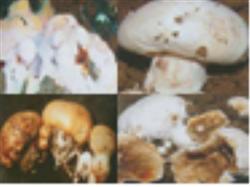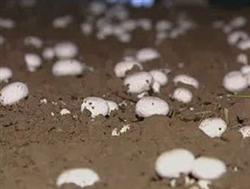Interplanting technique of Cucumber and Pleurotus ostreatus in Solar greenhouse

In order to increase the income of solar greenhouse, the three-dimensional planting experiment of vegetable and Pleurotus ostreatus was carried out. From October 2003 to May 2006, the net income of Pleurotus ostreatus was increased by more than 6500 yuan in a greenhouse of 420 square meters without affecting the cultivation of vegetables. The solar greenhouse is about 60 meters long and 7 meters wide. It is built in a place where the soil is fertile, irrigation and drainage are convenient, and the water quality is pollution-free. After the greenhouse is built, re-apply organic barnyard manure and potassium, phosphate fertilizer, deep leveling, and water again. Spray every corner evenly with 0.5% dichlorvos and triclofenac, then fumigate with 6 kg of sulfur for 3 days to completely kill the miscellaneous bacteria and pests in the greenhouse. Second, the cultivated varieties of cucumber were selected as dense thorns. After the first true leaf of cucumber seedlings grew in the seedling bed in early October, the pumpkin seedlings with flat cotyledons were grafted and transplanted to the cucumber border which was 1.2 meters wide and watered. Each row is 2 rows, the row spacing is 40 cm, the plant spacing is 25 cm, and the frame is set up after survival and normal management. 3. Cultivation of Pleurotus ostreatus. Production of culture materials for fermentation at the beginning of October, 1500 kg of wheat straw, 2000 kg of wet cow dung, 500kg of chicken manure, 20kg of urea, 50kg of calcium superphosphate, 50kg of lime and gypsum powder were needed for fermentation at the beginning of October. The excellent fermented material is brown, fragrant, pH 7.5, and water content 65%. two。 The disinfection of the culture material will be used in the fermentation shed at the end of October. Before that, the material was sprayed with appropriate amount of dicofol and dicofol and 400 times liquid of chlorpromazine, and it was stuffy for 24 hours. When the shed, cover the material on each row of cucumbers on both sides of each 20 cm wavy, north and south as a nursery bed. After the material enters the shed, sow the seeds according to 1 bottle of bacteria per square meter and gently press the material surface. 3. About 20 days after sowing, the hyphae ate 2 / 3 of the food to cover the soil. Before covering the soil, pour the reserved irrigation ditch with water, dig 7 cm deep on the second day, and cover the soil evenly on the wavy surface, about 3.5 cm thick. 4. The mushroom began to bud and produce mushroom about 40 days after sowing (mid-December). At this time, the cucumber vine grows to more than 1 meter, which creates a good shading environment for Pleurotus ostreatus, which is conducive to mushroom production. Spray mushroom water continuously for 3 days when budding, every day when the temperature is low in the morning and evening, press 400-700 ml / m2 water each time. Then stop water for 2 days, and then spray quality water, the method is the same as above. Pleurotus ostreatus and cucumber can be listed at the same time before New Year's Day, when the temperature is low, it is the off-season of vegetables, try to prolong the time of mushroom production, so that the mycelium fully rest and recuperate and increase the total yield. Fourth, integrated management 1. When the temperature of Pleurotus bisporus is coming out, the temperature in the greenhouse should be controlled at 20-30T in the daytime and 10T at night. When the room temperature is low due to the lack of daylighting in cloudy days, use electric lamps to increase the temperature at night, with a 100-watt bulb every 6 meters. two。 The humidity in the moisture greenhouse should be kept at 60% 80%. After watering or spraying, if the outside temperature is higher, it can be properly ventilated. When intercropping, the hyphae of Pleurotus ostreatus can absorb underground water, and the water spraying should be 1 / 3 less than that of the ordinary mushroom room. 3. Fertilizing cucumber should be watered with micro-fertilizer on a regular basis. After three batches of mushrooms, 0.2% potassium dihydrogen phosphate and 0.5% urea can be sprayed on cucumber leaves and bed surfaces of Pleurotus ostreatus. 4. To prevent diseases and insect pests during the period of stopping mushroom production, remove the mushroom root and dead mushroom in time, flatten the material surface, and fully spray insecticides and fungicides. Try not to use drugs, especially fungicides, during mushroom emergence to prevent damage to the mushroom body. The intercropping of vegetables and Pleurotus ostreatus can not only solve the problem that it is difficult to produce mushrooms in winter, but also reduce the investment, promote the growth of vegetables and improve the planting efficiency in greenhouse.
- Prev

How to control verrucosporium of Pleurotus ostreatus
Disease symptoms verrucosporium disease, also known as brown rot, white rot, wet bubble disease, blister disease, the disease is caused by a pathogen called verrucosporium. Alternaria verrucosa is a kind of soil fungus. In the cultivation of Pleurotus ostreatus, Alternaria verrucosa is mainly introduced into the mushroom room with the covered soil, which occurs in the mushroom shed with high temperature, high humidity and poor ventilation.
- Next

Using waste of Pleurotus ostreatus and Pleurotus ostreatus as organic fertilizer
There are more than 80,000 mu of rice in Haidian District, Beijing. Except for some straw, most of them are burned, which not only pollutes the environment but also wastes resources. According to this situation, we studied 9 mushroom species and finally determined that straw rot fungus Pleurotus ostreatus was one of the ways to utilize rice straw. The key techniques of cultivation of Pleurotus ostreatus are as follows. One.
Related
- Fuxing push coffee new agricultural production and marketing class: lack of small-scale processing plants
- Jujube rice field leisure farm deep ploughing Yilan for five years to create a space for organic food and play
- Nongyu Farm-A trial of organic papaya for brave women with advanced technology
- Four points for attention in the prevention and control of diseases and insect pests of edible fungi
- How to add nutrient solution to Edible Fungi
- Is there any good way to control edible fungus mites?
- Open Inoculation Technology of Edible Fungi
- Is there any clever way to use fertilizer for edible fungus in winter?
- What agents are used to kill the pathogens of edible fungi in the mushroom shed?
- Rapid drying of Edible Fungi

